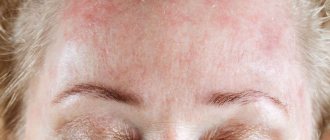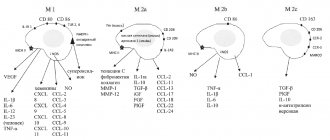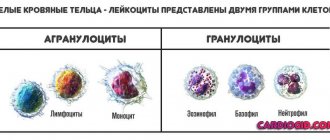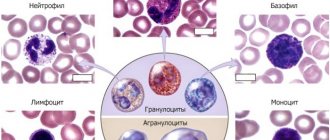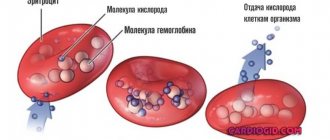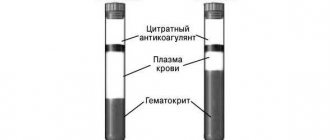Monocytes are the largest immune cells of all types of white blood cells and play an important role in protecting against bacteria and inflammation. What does an elevated monocyte count mean for your health? What factors can reduce their number? Find out about this in the article.
The article is based on the findings of 68 scientific studies
The article quotes authors such as:
- Rockefeller University, New York, USA
- Necker Hospital, Paris, France
- Department of Cell Biology and Genetics, Erasmus University Medical Center, Rotterdam, The Netherlands
Please note that the numbers in parentheses (1, 2, 3, etc.) are clickable links to peer-reviewed scientific studies. You can follow these links and read the original source of information for the article.
What are monocytes?
The front line of defense for your immune system
Monocytes are the largest type of white blood cell.
They help fight bacteria, viruses and other infections in your body. Along with other types of white blood cells, monocytes are a key part of your immune response. Only about 1% of your blood contains white blood cells, but they play a huge role in protecting against disease. Approximately 2 to 10% of all leukocytes are monocytes. (1) Your bone marrow produces monocytes and releases them into your bloodstream. Once they reach tissues in your body, they are called macrophages . There they isolate and devour germs and other harmful microorganisms. They also get rid of dead cells and promote the immune response. After leaving the bone marrow, monocytes circulate in the blood for several days before they enter tissues where they become macrophages or dendritic cells. (1, )
An example of how monocytes from the blood move into
an atherosclerotic plaque , becoming macrophages.
Monocytes adhere to the endothelium of blood vessels at sites of tissue damage, which leads to their activation and migration into the subendothelial space. Upon tissue entry, the monocyte differentiates into a macrophage. (source) Monocytes protect against viral, bacterial, fungal and protozoal infections. They kill microorganisms, absorb foreign particles, remove dead cells and enhance the immune response. (, 1, , )
However, they may also be involved in the development of inflammatory diseases such as arthritis and atherosclerosis. In this article, we'll take a closer look at how monocytes work and how they may be involved in disease. (, , )
Monocyte formation
All blood cells come from common parent cells called hematopoietic stem cells . In adults, blood cells are produced primarily in the bone marrow; this process is called hematopoiesis. The process of producing monocytes in particular is called myelopoiesis . (, )
Mechanisms of myelopoiesis (monocyte formation) during homeostasis and during different phases of infection and inflammation, illustrating important feedback loops between affected tissues and bone marrow.
Myelopoiesis is subject to a complex regulatory system, including such factors as:
- Transcription factor SPI1 (, , , )
- Cytokines: SCF (stem cell factor), GM-CSF (granulocyte-macrophage-colony-stimulating factor), M-CSF (macrophage colony-stimulating factor, CSF1), cytokines IL-3 and IL-6, and interferon IFN-gamma. (, , )
Monocytes live on average 3 days before undergoing apoptosis (programmed cell death). They live longer during periods of high inflammation; as soon as the inflammation disappears, monocyte death occurs. Such programmed death is necessary to prevent aggressive actions of immune cells from continuing inflammation and creating an autoimmune reaction. (, )
Monocytes and macrophages: what is the difference?
In the 70s of the last century, it was believed that all monocytes sooner or later turn into macrophages, and there are no other sources of “professional janitors” in the tissues of the human body. In 2008 and later, new studies were conducted that showed that macrophages are heterogeneous. Some of them actually originate from monocytes, while others arise from other progenitor cells even at the stage of intrauterine development.
The transformation of some cells into others follows a programmed pattern. Coming out of the bloodstream into the tissue, monocytes begin to grow, and the content of internal structures - mitochondria and lysosomes - increases. Such rearrangements allow monocyte macrophages to perform their functions as efficiently as possible.
Normal monocyte count
Normal ranges for monocytes can be expressed in several different standard units of measurement. Ask your doctor to help you interpret lab results.
Normal Monocyte Ranges:
- 0.2 – 0.8 x10^9/l (laboratory reference values 0.08 – 1.5x10^9/l)
- 1 – 10% (laboratory reference values 4 – 12.5%)
Monocyte counts in normal ranges help reduce the risk of developing and poor outcomes:
- viral, bacterial and fungal infections ()
- heart disease ()
- obesity()
- diabetes ()
- increase in mortality ()
Elevated monocyte count
Monocytosis is a condition in which the number of monocytes circulating in the blood increases to more than 0.8x10^9/L in adults.
Diseases with elevated monocyte levels
- Circulatory disorders (myelodysplastic disorders, acute monocytic, chronic myelomonocytic leukemia, Hodgkin and non-Hodgkin lymphoma) (, , )
- Infections (tuberculosis, viral infections, bacterial endocarditis, brucellosis, malaria, syphilis) (, , , , )
- Autoimmune diseases (systemic lupus erythematosus, rheumatoid arthritis, inflammatory bowel disease) (, , )
- Sarcoidosis ()
- Malignant tumors (ovary, breast, rectum) ()
- Heart attack - infarction ()
- Appendicitis ()
- HIV infection
- Depression()
- Obesity ()
- Severe pneumonia ()
- Alcoholic liver disease ()
Monocytosis most often occurs during and after chronic inflammation or infection. () However, several other problems may be associated with monocytosis: heart disease, depression, diabetes and obesity. (, , )
The most common conditions and diseases associated with high monocyte levels are:
- Chronic (long-term) inflammation of any etiology ()
- Infections such as tuberculosis, malaria and syphilis (, , )
Monocytes are involved in human disease both directly through their functional effects and indirectly through their differentiation into macrophages . Diet influences the number of nonclassical monocytes, monocyte migration, and cytokine production, the effects of which are counteracted by fasting. Additionally, the epigenetic landscape is altered by metabolites in a process called innate immune memory. In atherosclerosis, monocytes differentiate into foam cells, which secrete proinflammatory cytokines and chemokines, accumulate lipids, and possibly participate in calcification. Monocytes exhibit high heterogeneity and their functions can be impaired, as in COPD , while the location of monocytes appears to be critical in lung cancer , with monocytes close to tumors being immunocompromised. Finally, monocytes infiltrate the brain in neurodegenerative diseases such as Alzheimer's disease .
(source) Few symptoms of inflammatory diseases are associated with monocytosis itself. According to many scientists, such symptoms arise from diseases associated with the development of monocytosis. () These symptoms consist of: fever (), pain (), tissue swelling. ()
Reasons for the increase in monocytes in the blood
An increase in monocytes above the threshold value for each age group is called monocytosis. There are two forms of this condition:
- Absolute monocytosis is a phenomenon when there is an isolated growth of monocytes in the blood, and their concentration exceeds 0.8*109/l for adults and 1.1*109/l for children under 12 years of age. A similar condition is recorded in some diseases that provoke the specific production of professional phagocytes.
- Relative monocytosis is a phenomenon in which the absolute number of monocytes remains within normal limits, but their percentage in the bloodstream increases. This condition occurs when the level of other white blood cells decreases simultaneously.
In practice, absolute monocytosis is a more alarming sign, since it usually indicates serious problems in the body of an adult or child. The relative increase in monocytes is often transient.
What does an excess of monocytes indicate? First of all, it means that phagocytosis reactions have started in the body, and there is an active fight against foreign invaders. The following conditions can cause monocytosis:
Physiological causes of monocytosis
In all healthy people, monocytes increase slightly in the first two hours after eating. It is for this reason that doctors recommend donating blood exclusively in the morning and on an empty stomach. Until recently, this was not a strict rule, and a general blood test with determination of the leukocyte formula was allowed to be done at any time of the day. Indeed, the increase in monocytes after a meal is not so significant and usually does not exceed the upper threshold, but the risk of incorrect interpretation of the result still remains. With the introduction into practice of devices for automatic decoding of blood, sensitive to the slightest changes in cellular composition, the rules for taking the test were revised. Today, doctors of all specialties insist that the OAC be taken on an empty stomach in the morning.
High monocytes in women occur in some special situations:
Menstruation
In the first days of the cycle, healthy women experience a slight increase in the concentration of monocytes in the blood and macrophages in the tissues. This is explained quite simply - it is during this period that active rejection of the endometrium occurs, and “professional janitors” rush to the hearth to perform their immediate duties. The growth of monocytes is observed at the peak of menstruation, that is, on the days of the most heavy discharge. After the monthly bleeding is completed, the level of phagocyte cells returns to normal.
Important! Although the number of monocytes during menstruation usually does not go beyond the normal range, doctors do not recommend taking a complete blood count until the end of your monthly discharge.
Pregnancy
The restructuring of the immune system during pregnancy leads to low levels of monocytes in the first trimester, but then the picture changes. The maximum concentration of blood cells is recorded in the third trimester and before birth. The number of monocytes usually does not exceed the age norm.
Pathological causes of monocytosis
Conditions in which monocytes are so elevated that they are determined in a general blood test to be outside the normal range are considered pathological and require mandatory consultation with a doctor.
Acute infectious diseases
The growth of professional phagocytes is observed in various infectious diseases. In a general blood test, the relative number of monocytes in ARVI slightly exceeds the threshold values accepted for each age. But if during a bacterial infection there is an increase in neutrophils, then in the event of a viral attack, monocytes enter the battle. A high concentration of these blood elements is recorded from the first days of illness and persists until complete recovery.
- After all symptoms subside, monocytes remain high for another 2-4 weeks.
- If an elevated monocyte count is recorded for 6-8 weeks or more, a source of chronic infection should be sought.
With a common respiratory infection (cold), the level of monocytes increases slightly and is usually at the upper limit of normal or slightly beyond its limits (0.09-1.5 * 109/l). A sharp increase in monocytes (up to 30-50*109/l or more) is observed in oncohematological diseases.
An increase in monocytes in a child is most often associated with the following infectious processes:
Infectious mononucleosis
The disease caused by the herpes-like Epstein-Barr virus occurs primarily in preschool children. The prevalence of the infection is such that almost everyone gets it by adolescence. It almost never occurs in adults due to the peculiarities of the immune system's response.
Symptoms:
- Acute onset with fever up to 38-40 °C, chills.
- Signs of upper respiratory tract damage: runny nose, nasal congestion, sore throat.
- Almost painless enlargement of the occipital and submandibular lymph nodes.
- Skin rash.
- Enlarged liver and spleen.
Fever during infectious mononucleosis persists for a long time, up to a month (with periods of improvement), which distinguishes this pathology from other acute respiratory viral infections. In the general blood test, both monocytes and lymphocytes are elevated. The diagnosis is made based on the typical clinical picture, but a test for specific antibodies may be performed. Therapy is aimed at relieving the symptoms of the disease. Targeted antiviral treatment is not carried out.
Other childhood infections
The simultaneous growth of monocytes and lymphocytes is observed in many infectious diseases that occur mainly in childhood and are almost not detected in adults:
- measles;
- rubella;
- whooping cough;
- mumps, etc.
In these diseases, monocytosis is observed in the case of protracted pathology.
In adults, other causes of an increase in the number of monocytes in the blood are identified:
Tuberculosis
A severe infectious disease that affects the lungs, bones, genitourinary organs, and skin. You can suspect the presence of this pathology based on certain signs:
- Long-lasting causeless fever.
- Unmotivated weight loss.
- Prolonged cough (with pulmonary tuberculosis).
- Lethargy, apathy, increased fatigue.
Annual fluorography helps identify pulmonary tuberculosis in adults (in children, the Mantoux test). A chest x-ray helps confirm the diagnosis. To detect tuberculosis of other localizations, specific studies are carried out. In the blood, in addition to an increase in the level of monocytes, there is a decrease in leukocytes, erythrocytes and hemoglobin.
Other infections can lead to monocytosis in adults:
- brucellosis;
- syphilis;
- sarcoidosis;
- cytomegalovirus infection;
- typhoid fever, etc.
The growth of monocytes is observed during a prolonged course of the disease.
Parasitic infestation
Activation of monocytes in the peripheral blood is observed during helminth infection. These can be either opisthorchid, bovine or pork tapeworm, pinworms and roundworms, which are common in temperate climates, or exotic parasites. When the intestines are damaged, the following symptoms occur:
- Abdominal pain of various localizations.
- Loss of stool (usually diarrhea).
- Unmotivated weight loss due to increased appetite.
- Allergic skin reaction such as urticaria.
Along with monocytes, an increase in eosinophils, granulocytic leukocytes responsible for the allergic reaction, is recorded in the blood of a person infected with helminths. To identify parasites, feces are taken for analysis, bacteriological cultures are done, and immunological tests are performed. Treatment includes taking antiparasitic medications depending on the source of the problem found.
Chronic infectious and inflammatory processes
Almost any indolent infection that exists in the human body for a long time leads to an increase in the level of monocytes in the blood and the accumulation of macrophages in tissues. It is difficult to identify specific symptoms in this situation, since they will depend on the form of the pathology and the location of the lesion.
This could be an infection of the lungs or throat, heart muscle or bone tissue, kidneys and gallbladder, or pelvic organs. This pathology is manifested by constant or periodically occurring pain in the projection of the affected organ, increased fatigue, and lethargy. Fever is not typical. After identifying the cause, optimal therapy is selected, and as the pathological process subsides, the level of monocytes returns to normal.
Autoimmune diseases
This term refers to conditions in which the human immune system perceives its own tissues as foreign and begins to destroy them. At this moment, monocytes and macrophages come into play - professional phagocytes, well-trained soldiers and janitors, whose task is to get rid of the suspicious focus. But with autoimmune pathology, this focus becomes one’s own joints, kidneys, heart valves, skin and other organs, from which all the symptoms of the pathology appear.
The most common autoimmune processes:
- Diffuse toxic goiter is a lesion of the thyroid gland, in which increased production of thyroid hormones occurs.
- Rheumatoid arthritis is a pathology accompanied by the destruction of small joints.
- Systemic lupus erythematosus is a condition that affects skin cells, small joints, heart valves, and kidneys.
- Systemic scleroderma is a disease that affects the skin and spreads to internal organs.
- Type I diabetes mellitus is a condition in which glucose metabolism is impaired, and other parts of metabolism are also affected.
The growth of monocytes in the blood in this pathology is only one of the symptoms of systemic damage, but does not act as a leading clinical sign. To determine the cause of monocytosis, additional tests are required taking into account the suspected diagnosis.
Oncohematological pathology
A sudden increase in monocytes in the blood is always scary, as it may indicate the development of malignant blood tumors. These are serious conditions that require a serious approach to treatment and do not always end well. If monocytosis cannot be associated with infectious diseases or autoimmune pathology, you should see an oncohematologist.
Blood diseases leading to monocytosis:
- Acute monocytic and myelomonocytic leukemia. A variant of leukemia in which monocyte precursors are detected in the bone marrow and blood. It is found mainly in children under 2 years of age. Accompanied by signs of anemia, bleeding, and frequent infectious diseases. There is pain in the bones and joints. It has a poor prognosis.
- Multiple myeloma. It is detected mainly after the age of 60 years. It is characterized by the appearance of bone pain, pathological fractures and bleeding, and a sharp decrease in immunity.
The number of monocytes in oncohematological diseases will be significantly higher than normal (up to 30-50*109/l and higher), and this makes it possible to distinguish monocytosis in malignant tumors from a similar symptom in acute and chronic infections. In the latter case, the concentration of monocytes rises slightly, while in leukemia and myeloma there is a sharp increase in agranulocytes.
Other malignancies
If monocytes grow in the blood, attention should be paid to lymphogranulomatosis (Hodgkin's disease). The pathology is accompanied by fever, enlargement of several groups of lymph nodes and the appearance of focal symptoms in various organs. Possible damage to the spinal cord. To confirm the diagnosis, puncture of the altered lymph nodes is performed with histological examination of the material.
An increase in monocytes is also observed in other malignant tumors of various locations. To identify the cause of such changes, targeted diagnostics are required.
Chemical poisoning
A rare cause of monocytosis that occurs in the following situations:
- Tetrachloroethane poisoning occurs when the substance is inhaled or ingested through the mouth or skin. Accompanied by irritation of the mucous membranes, headache, jaundice. In the long term, it can lead to liver damage and coma.
- Phosphorus poisoning occurs through contact with contaminated vapor or dust or accidental ingestion. In acute poisoning, stool loss and abdominal pain are observed. Without treatment, death occurs as a result of damage to the kidneys, liver and nervous system.
Monocytosis in case of poisoning is only one of the symptoms of the pathology and occurs in combination with other clinical and laboratory signs.
Low monocyte count (monocytopenia)
With monocytopenia, the number of monocytes circulating in the blood decreases to less than 0.2 × 10^9/L in adults. Monocytopenia itself does not appear to cause symptoms, and patients usually experience only symptoms associated with the associated condition. Similar symptoms may include fatigue and fever. (, )
Diseases and conditions with low monocyte levels
- Aplastic anemia ()
- Leukemia (hairy cell leukemia, chronic lymphocytic leukemia) ()
- Carrying out chemotherapy ()
- Radiation therapy ()
- monoMAC syndrome (monocytopenia and mycobacterial infection) ()
- Severe burn injuries ()
- Rheumatoid arthritis ()
- Systemic lupus erythematosus ()
- HIV infection ()
- Vitamin B12 deficiency ()
- Corticosteroid therapy (transient monocytopenia) ()
- Administration of drugs: interferon-alpha and TNF-alpha ()
Reasons for the decrease in monocytes in the blood
Monocytopenia is a decrease in monocytes in the blood below a threshold value. A similar symptom occurs in the following conditions:
- Purulent bacterial infections.
- Aplastic anemia.
- Oncohematological diseases (late stages).
- Taking certain medications.
Reduced monocytes are somewhat less common than an increase in their number in the peripheral blood, and often this symptom is associated with serious diseases and conditions.
Purulent bacterial infections
This term refers to diseases in which pyogenic bacteria invade and inflammation develops. We are usually talking about streptococcal and staphylococcal infections. Among the most common purulent diseases it is worth highlighting:
- Skin infections: boil, carbuncle, cellulitis.
- Bone damage: osteomyelitis.
- Bacterial pneumonia.
- Sepsis is the entry of pathogenic bacteria into the blood with a simultaneous decrease in the overall reactivity of the body.
Some purulent infections tend to self-destruct, others require mandatory medical intervention. In the blood test, in addition to monocytopenia, there is an increase in the concentration of neutrophilic leukocytes - cells responsible for a rapid attack at the site of purulent inflammation.
Aplastic anemia
Low monocytes in adults can occur in various forms of anemia, a condition in which there is a lack of red blood cells and hemoglobin. But if iron deficiency and other variants of this pathology respond well to therapy, then aplastic anemia deserves special attention. With this pathology, there is a sharp inhibition or complete cessation of the growth and maturation of all blood cells in the bone marrow, and monocytes are no exception.
Symptoms of aplastic anemia:
- Anemic syndrome: dizziness, loss of strength, weakness, tachycardia, pale skin.
- Bleeding of various localizations.
- Decreased immunity and infectious complications.
Aplastic anemia is a severe hematopoietic disorder. Without treatment, patients die within a few months. Therapy involves eliminating the cause of anemia, taking hormones and cytostatics. A bone marrow transplant has a good effect.
Oncohematological diseases
In the later stages of leukemia, inhibition of all hematopoietic germs and the development of pancytopenia are noted. Not only monocytes suffer, but also other blood cells. There is a significant decrease in immunity and the development of severe infectious diseases. Unreasonable bleeding occurs. Bone marrow transplantation is the optimal treatment option in this situation, and the sooner the operation is performed, the greater the chance of a favorable outcome.
Taking medications
Some medications (corticosteroids, cytostatics) inhibit bone marrow function and lead to a decrease in the concentration of all blood cells (pancytopenia). With timely assistance and discontinuation of the drug, bone marrow function is restored.
Monocytes are not just professional phagocytes, janitors of our body, ruthless killers of viruses and other dangerous elements. These white blood cells are a marker of health along with other indicators of a complete blood count. If your monocyte level increases or decreases, you should definitely see a doctor and undergo an examination to find the cause of this condition. Making a diagnosis and selecting a treatment regimen is carried out taking into account not only laboratory data, but also the clinical picture of the identified disease.
Author:
Selezneva Valentina Anatolyevna physician-therapist
Link between elevated monocyte levels and health status
Atherosclerosis
Monocytes and macrophages are involved in the development and worsening of atherosclerosis, which can lead to various heart diseases and stroke. ()
The accumulation of monocytes and macrophages loaded with cholesterol leads to plaque rupture and thrombus formation. (source)
Monocytes accumulate in blood vessels and promote the development and rupture of atherosclerotic plaques, which block the blood vessels. (, , )
As atherosclerosis progresses, the number of monocytes in the blood tends to increase. ()
Chronic inflammation in diabetes
A clinical study found no association between diabetes mellitus and the number of circulating white blood cells, but monocytes were significantly more numerous in people with complications of diabetes mellitus. (42)
Some scientists believe that monocytes may be responsible for the harmful inflammatory complications of type 2 diabetes. Studies have shown that monocytes secrete the cytokines TNF-alpha, IL-6 and IL-1 in both type 1 and type 2 diabetic . These pro-inflammatory molecules (cytokines) are thought to contribute to the development of blood vessel diseases (such as atherosclerosis). (, , , , , )
Mortality rates and monocyte counts
In a large study of more than 4,000 adult patients in a Swiss hospital, people with monocytosis had more and more severe than those who did not have elevated monocyte counts. In addition, patients with monocytosis had lower survival rates during their hospital stay. ()
In a separate study of older Korean men and women, monocytosis was associated with an increased risk of cardiovascular and cancer death. ()
But this relationship has not been studied well enough to say for sure that monocytosis can predict mortality rates. However, modern research has largely supported this association. (, , )
Heart recovery after a heart attack
After a heart attack (infarction), monocytes repair damage to the heart by destroying damaged and dead heart cells. However, animal studies suggest that increased monocyte counts are associated with impaired healing after infarction. (, )
Hormones and increased monocytes
Leptin
The hormone leptin increases the number of monocytes and their production of cytokines, since leptin is a pro-inflammatory cytokine. () Leptin levels correlate with body weight: in obesity, leptin is often elevated.
Decrease in estrogen during menopause
An increase in the number of monocytes in the blood of women has been found during menopause, when estrogen levels decrease. In addition, the number of monocytes decreases after estrogen replacement therapy. ()
A growth hormone
Growth hormone increases the number of white blood cells, including monocytes. ()
Testosterone
Testosterone injections increased the number of monocytes, granulocytes and large lymphocytes in mice. ()
Leukocytes - what are they?
Leukocytes are the body’s protective army. They make up a large group of white blood cells whose purpose is to rid the body of infections. Leukocytes take part in allergic, autoimmune and tumor processes. White cells are divided into types, which are responsible for their specific function.
A complete blood count shows the total number of cells. The leukocyte count is responsible for accurately identifying the cell types that cause an increase (leukocytosis) or decrease (leukopenia) in white cells in the blood. The formula can be found in an expanded form of a blood test. There are five types of cells, their number and relationship to each other.
The blood test is assessed using an automatic analyzer, which calculates the percentage of each type of the total number of cells. The device also calculates the white blood cell count per liter of blood.
Additionally, a visual assessment of the blood smear using a microscope may be required. A “manual” check of analyzes may be necessary in the following cases:
• Changes in the leukocyte formula; • There are altered or immature cells; • Signs of anemia are visible; • Reduced platelet count.
If the analysis is processed manually, only the percentage will be visible. Each type of assessment allows you to correctly diagnose diseases, understand their causes and prescribe the correct treatment.
Ways to lower monocyte levels
Monocytosis is a condition that requires diagnosis and treatment by a healthcare professional. Talk to your doctor before trying any strategies to reduce your monocyte count.
Regular exercise
Regular physical activity has an anti-inflammatory effect . In one study, monocytes were significantly reduced by 6 weeks of cycling training in overweight women who did not exercise regularly.
As
we age , there is an increase in general inflammation and a decrease in immune capabilities. In particular, the number of monocytes increases . But physical activity and diet can reduce the level of monocytes, and transfer macrophages from the M1 type to the less inflammatory M2 type.
(source) Monocyte count (decrease in monocyte count) was also significantly associated with decreased triglyceride levels, increased insulin sensitivity, and decreased body mass index (weight loss). All these changes in the body occur under the influence of physical activity. ()
Weight loss
In obese people, weight loss was accompanied by a significant decrease in the number of monocytes and neutrophils . A decrease in the number of circulating monocytes correlated with better insulin sensitivity of body tissues, which prevented the development of metabolic syndrome. ()
Omega-3 fatty acids
Regular consumption of omega-3 fatty acids, found in fatty fish such as mackerel and salmon, or in fish oil supplements, may protect against atherosclerosis and heart disease. ()
People taking fish oil supplements were less likely to show inflammation in the walls of blood vessels caused by monocyte activity. This effect was not as pronounced in people already taking special medications to treat peripheral blood vessel disease. ()
Moderate alcohol consumption
Alcohol affects monocyte function. In one study, the monocytes of people who drank moderate amounts of alcohol were less active, even after just one drink. Monocytes directly exposed to alcohol also had a reduced inflammatory response to proinflammatory proteins. (, )
Moderate alcohol consumption, about 1 or 2 standard drinks per day, is associated with significantly reduced monocyte production of the inflammatory cytokines TNF-alpha and IL-1beta. Alcohol is also associated with increased production of the cytokine IL-10, which is an anti-inflammatory protein. (, )
However, we do not recommend increasing alcohol consumption in order to relieve inflammation. Talk to your doctor about more appropriate anti-inflammatory actions.
Mediterranean diet
Some studies demonstrate that the Mediterranean diet can reduce inflammation caused by monocytes. (, )
PYRAMID OF THE MEDITERRANEAN DIET
The Mediterranean diet consists of foods such as seeds, nuts, vegetables, fruits, whole grains and monounsaturated fats from olive oil.
Starvation
Intermittent or prolonged fasting can reduce the proinflammatory activity of monocytes. For example, the short-chain fatty acid β-hydroxybutyrate, which when released from the liver during prolonged fasting , has been shown to suppress the production of the cytokines IL-1β and IL-18 by human monocytes, which was induced by the NLRP3 inflammasome. ()
Calorie restriction has beneficial effects on many chronic metabolic disorders such as type 2 diabetes, nonalcoholic fatty liver disease, and cardiovascular disease, and intermittent fasting is sufficient to reduce the number of all monocyte populations in healthy individuals. ()
Taking cortisol
When a single dose of cortisol is administered, the number of monocytes decreases by 90% 4-6 hours after receiving the drug. This decline in numbers lasted for about 24 hours. Subsequently, monocyte levels return to normal 24 to 72 hours after cortisol treatment. ()
Taking estrogen
According to one study, estrogen (and possibly also progesterone) reduces the number of monocytes by preventing their production. This mechanism could explain why cell-mediated immunity appears to be suppressed during pregnancy . ()
Medicine: infliximab
Infliximab (monoclonal antibody TNF-alpha) is an immunosuppressive drug prescribed to treat inflammatory diseases such as Crohn's disease, ulcerative colitis, and rheumatoid arthritis. (, , )
Infliximab inhibits monocytes, which may help reduce inflammation in patients with chronic inflammatory diseases. ()
Link between low monocyte levels and health status
Cardiovascular diseases
Of all white blood cells, monocyte counts have the strongest association with the incidence of cardiovascular disease in people without any symptoms. Lower monocyte levels are directly associated with lower cardiovascular risk of disease and death. ()
Link of monocytes (increased levels) in cardiovascular diseases (source)
Susceptibility to infections
Monocytes are involved in the immune response to infection , so it is not surprising that low monocyte counts are associated with increased infection rates. Monocytopenia is directly associated with monoMAC syndrome: increased susceptibility to mycobacterial infections, fungal infections, and human papillomavirus (HPV). (, )
Hematopoietic disorders
Monocytopenia is associated with blood disorders such as myelodysplasia, acute myelogenous leukemia, chronic myelomonocytic leukemia, and lymphomas. If you are concerned about your low monocyte count and your possible risk of these blood disorders, talk to your doctor about additional tests available. ()
Cervical cancer
Patients with primary immunodeficiency have insufficient numbers of monocytes and are susceptible to severe, persistent human papillomavirus (HPV) infections, which can cause cervical cancer. If you have problems with your monocytes, talk to your doctor about strategies to prevent cervical cancer, especially if you have not been vaccinated against HPV. (, )
When is the indicator normal?
So, you have a piece of paper in your hands with a summary of various parameters, including: leukocytes, erythrocytes, platelets, hemoglobin level and some others. We reach with our eyes the point “monocytes”. Normally, this figure in a healthy person ranges from 3 to 11%. If your level is higher, it means your body is fighting some kind of disease and you should visit your doctor for further testing. It should be noted that this parameter varies for different age groups and genders. And if in adult men and women the monocyte rate is approximately the same (3-10%), then for children there are some nuances. So, the optimal content of mononuclear phagocytes is:
- For newborns: 3-12%
- For babies up to two weeks: 5-15%
- From one month to a year: 4-10%
- Up to two years: 3-10%
- For children under 16 years old: 3-9%

